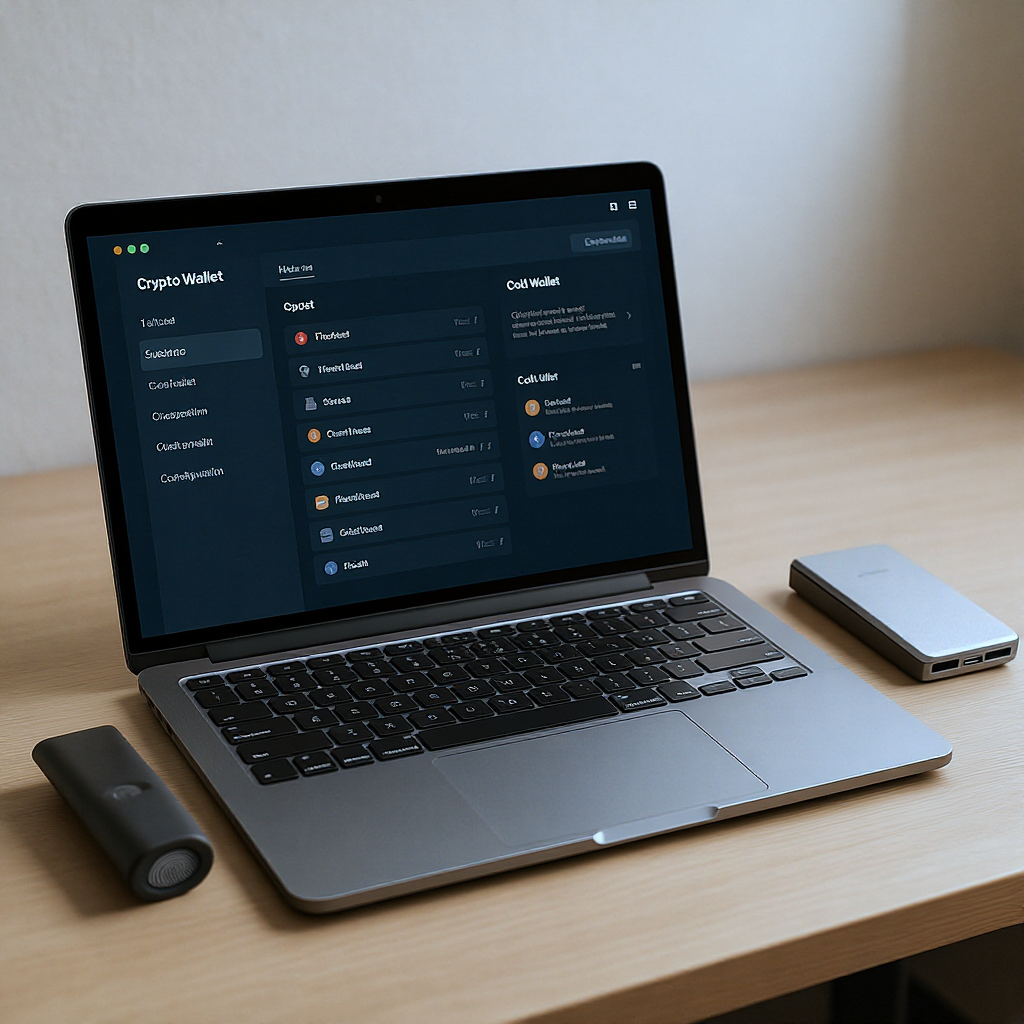Beginner’s Guide to Setting Up and Securing Crypto Wallets

Why You Need to Secure Your Crypto Wallet
Imagine standing on the edge of a vast, uncharted territory—cryptocurrency is just that, a frontier filled with both opportunities and risks. So, why should you care about securing your crypto wallet? Because in this new digital age, your wallet is not just a vault; it’s your ticket to financial autonomy. But here’s the catch: if you don’t protect it, that ticket could easily slip through your fingers.
The stakes are high. With the rapid evolution of digital assets, securing your crypto wallet has never been more crucial. Recent trends show that wallets now offer cutting-edge security features like biometric authentication and multi-signature support. You might be thinking, “That sounds complicated!” But don’t worry. By the end of this guide, you’ll not only understand these features but also how to leverage them for your safety.
The Landscape of Crypto Wallets: What You Should Know
Types of Wallets Hot vs. Cold
Let’s break it down. There are two primary types of wallets:
– Hot Wallets: These are connected to the internet. They’re perfect for daily transactions but come with increased risk—think of them as an unlocked door to your home.
– Cold Wallets: These are your offline options, like hardware wallets, that are vastly more secure. They’re akin to a safe hidden away in your basement—out of sight and out of reach.
Security Essentials You Can’t Ignore
The security of your wallet hinges on two critical components:
– Private Keys: This is your secret code. Guard it like you would your Social Security number. Losing it means losing access to your funds forever.
– Recovery Phrases: Think of these as a lifeline. If you ever lose access, this set of words can restore your wallet. Store it securely offline; it’s your backup plan in a crisis.
Setting Up Your Wallet A Step-by-Step Guide
Choosing the Right Wallet for You
Before diving into setup, ask yourself:
– Are you a beginner or a seasoned user? For newcomers, hosted wallets like Coinbase offer a gentle learning curve. On the other hand, if you’re more experienced, you might prefer non-custodial wallets like MetaMask for greater control.
Setting Up a Hosted Wallet
- Create an Account: Head over to your chosen platform and sign up.
- Strong Password: Choose a password that’s not just strong but unique. Think of it as the lock on your door.
- Enable 2FA: Two-factor authentication adds an extra layer of security, like a second lock on that door.
Setting Up a Non-Custodial Wallet
- Download the App: Get your wallet application from a trusted source.
- Create a New Wallet: Follow the prompts to set up.
- Securely Store Your Recovery Phrase: Don’t just jot it down; safeguard it like your most prized possession.
Best Practices for Wallet Security
- Use Strong Passwords: Complexity is key. Think of a password that would stump even your cleverest friend.
- Regular Backups: Don’t wait for the unexpected to happen. Backup your wallet periodically and keep it in a secure location.
- Beware of Phishing: Always double-check that you’re on the official site or app. It’s easy to be tricked!
- Cold Storage for Large Holdings: If you have significant assets, consider moving them to a hardware wallet. It’s like storing your cash in a safe, rather than keeping it in your wallet.
Concluding Thoughts Empower Yourself
By now, you should feel more equipped to embark on your cryptocurrency journey. The world of digital assets is both thrilling and intimidating, but securing your wallet doesn’t have to be. Embrace these steps, invest your time in understanding the tools available, and remember: the more informed you are, the safer your assets will be.
So, are you ready to take control of your financial future? The first step is setting up and securing your crypto wallet. Let’s get started!
Advanced Strategies for Securing Your Crypto Wallet
Embarking on your cryptocurrency journey is akin to stepping into a vast ocean—full of potential yet fraught with unseen dangers. As you dive deeper, simply setting up a wallet isn’t enough; it’s imperative to adopt advanced security strategies. Let’s explore some nuanced methodologies that will fortify your crypto holdings against threats and ensure peace of mind.
Understanding Threat Vectors
Before we secure your wallet, it’s vital to comprehend the landscape of threats.
-
Phishing Attacks: These are deceitful attempts to obtain sensitive information by masquerading as trustworthy entities. They can come in various forms—emails, fake websites, or even text messages. Always verify the source before clicking any links.
-
Malware: Malicious software can infiltrate your devices, capturing keystrokes and access credentials. Installing robust antivirus solutions and regularly updating your software can mitigate these risks.
-
Physical Theft: If your wallet is stored on a device that can be physically accessed, it’s at risk. This is where cold storage solutions come into play.
Multi-Layered Security Approaches
Implementing a multi-layered security approach can significantly enhance the safety of your crypto assets.
Decentralized Identity Verification
Consider using decentralized identity solutions. These systems allow you to authenticate your identity without exposing sensitive information. For instance, platforms like Civic offer secure identity verification methods that don’t compromise your privacy.
Hardware Wallets
Investing in a hardware wallet such as Ledger or Trezor is akin to putting your cash in a safe rather than a wallet. These devices store your private keys offline, making them impervious to online threats. Here’s how to leverage one:
- Purchase from Official Sources: Always buy directly from the manufacturer to avoid counterfeit devices.
- Set Up with Care: Follow the manufacturer’s guidelines meticulously. During setup, ensure that your recovery phrase is stored securely and never shared.
- Keep Firmware Updated: Regularly check for firmware updates to protect against vulnerabilities.
Backup Strategies
Backing up your wallet isn’t just a precaution; it’s a necessity.
-
Cold Storage Techniques: Store your recovery phrases in a secure location, such as a safe deposit box. This ensures that even in the event of theft or loss, your assets remain retrievable.
-
Redundancy: Don’t rely on a single backup method. Consider multiple forms of storage—physical copies, encrypted USB drives, or even secure cloud storage with end-to-end encryption.
Navigating Wallet Interactions
As you engage with the crypto ecosystem, understanding how to interact safely with your wallet is crucial.
Engaging with Decentralized Applications (dApps)
When connecting your wallet to dApps, exercise caution. These platforms can offer great opportunities but also come with risks.
- Verify the dApp: Before connecting your wallet, ensure the dApp is reputable. Check community feedback and reviews. Websites like DeFi Safety provide insights into the security of various platforms.
- Use Transaction Limits: Some wallets allow you to set transaction limits. This feature can prevent large unauthorized transactions in case of an exploit.
Regular Security Audits
Conducting regular security audits of your wallet practices can help identify potential vulnerabilities.
- Review Access Logs: If your wallet supports it, review logs to see any unusual access attempts.
- Audit Your Security Practices: Periodically reassess your security measures. Ask yourself: Are my passwords strong enough? Am I still using two-factor authentication?
Cost-Benefit Analysis of Security Measures
While some security measures might come with costs, consider this a necessary investment in your financial future. Here’s a comparative analysis of various security strategies:
| Security Measure | Cost | Benefits | Downsides |
|---|---|---|---|
| Hardware Wallet | $50 – $200 | High security, offline storage | Initial investment needed |
| Decentralized Identity | Varies | Enhanced privacy, reduced phishing risk | Adoption can be complex |
| Regular Backups | Minimal | Peace of mind, asset retrievability | Requires diligence |
| Two-Factor Authentication | Free | Adds an extra layer of security | Can be bypassed if device compromised |
Real-Life Case Studies
Understanding the implications of wallet security through real-life examples can provide clarity on the importance of these practices.
Case Study The Mt. Gox Incident
In 2014, Mt. Gox, one of the largest Bitcoin exchanges at the time, was hacked, leading to the loss of 850,000 Bitcoins. This incident underscored the importance of securing not only wallets but also exchanges. Customers lost faith in centralized exchanges, leading to a surge in decentralized alternatives.
Case Study The Parity Wallet Hack
In 2017, the Parity wallet experienced a vulnerability that led to the freezing of $150 million worth of Ether. This incident highlighted the risks of poorly tested smart contracts and the need for robust security practices when interacting with decentralized platforms.
Final Thoughts: Your Wallet, Your Responsibility
As you navigate the world of cryptocurrencies, remember—your wallet is your responsibility. The steps you take today to secure it can safeguard your financial future tomorrow. Are you ready to take the plunge and implement these security strategies? The time to act is now. Embrace the tools and knowledge at your disposal, and transform your crypto journey into a secure venture.
Ultimately, the world of cryptocurrency is thrilling and filled with potential, but it’s your prudent actions that will determine your success. So, what will your next move be?

Summary of Key Points
As we’ve explored throughout this guide, securing your crypto wallet is an essential step toward navigating the vast world of digital currency safely. Here’s a quick recap of the foundational concepts we covered:
- Types of Wallets: Understanding the difference between hot wallets, ideal for everyday transactions, and cold wallets, which provide enhanced security for long-term holdings.
- Security Essentials: The critical importance of private keys and recovery phrases—your lifelines in the crypto space.
- Setting Up Your Wallet: A step-by-step approach for both hosted and non-custodial wallets ensures you start your journey on the right foot.
- Best Practices for Security: From strong passwords to avoiding phishing scams, these strategies are your shield against potential threats.
- Advanced Strategies: Engaging with decentralized applications safely and implementing multi-layered security for comprehensive protection.
By grasping these core elements, you are now better equipped to manage and secure your crypto assets.
Guidance on Next Steps
So, what should you do next? Here are some actionable steps you can take to solidify your understanding and security:
- Choose Your Wallet Wisely: Reflect on your needs and select the wallet that best fits your comfort level and security requirements.
- Implement Security Measures: Start using two-factor authentication, strong passwords, and regular backups. Make these practices a habit—your future self will thank you.
- Stay Informed: The crypto landscape is ever-evolving. Regularly check reputable sources for news on security threats and wallet updates to stay ahead of potential risks.
Regular Check-Ins
- Set a recurring reminder to review your wallet security practices, ensuring that your methods remain robust against new threats.
- Engage with online communities or forums to share experiences and gather insights from fellow crypto enthusiasts.
Final Advice for Reader Success
Navigating the world of cryptocurrency can be intimidating, but remember: your wallet security is your responsibility.
“The best time to plant a tree was twenty years ago. The second best time is now.”
Take proactive steps today to secure your assets and empower yourself in this financial frontier.
As you venture deeper, consider exploring topics such as:
– Decentralized Finance (DeFi): Understanding its implications and how it can provide new opportunities.
– Smart Contracts: Learning how they work can enhance your engagement with the crypto ecosystem.
– Cryptocurrency Trading Strategies: Equip yourself with knowledge on how to navigate the market effectively.
By continuing to educate yourself and applying the principles outlined in this guide, you can confidently take control of your financial future. Are you ready to embrace the challenge? Let’s dive in!



